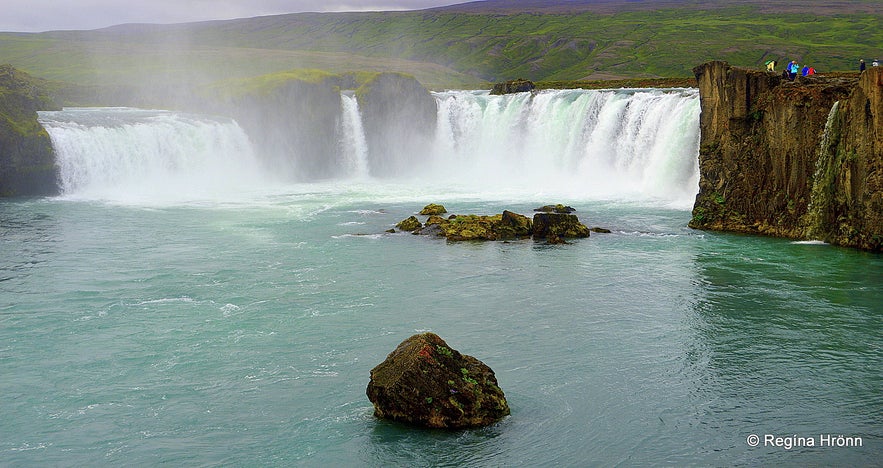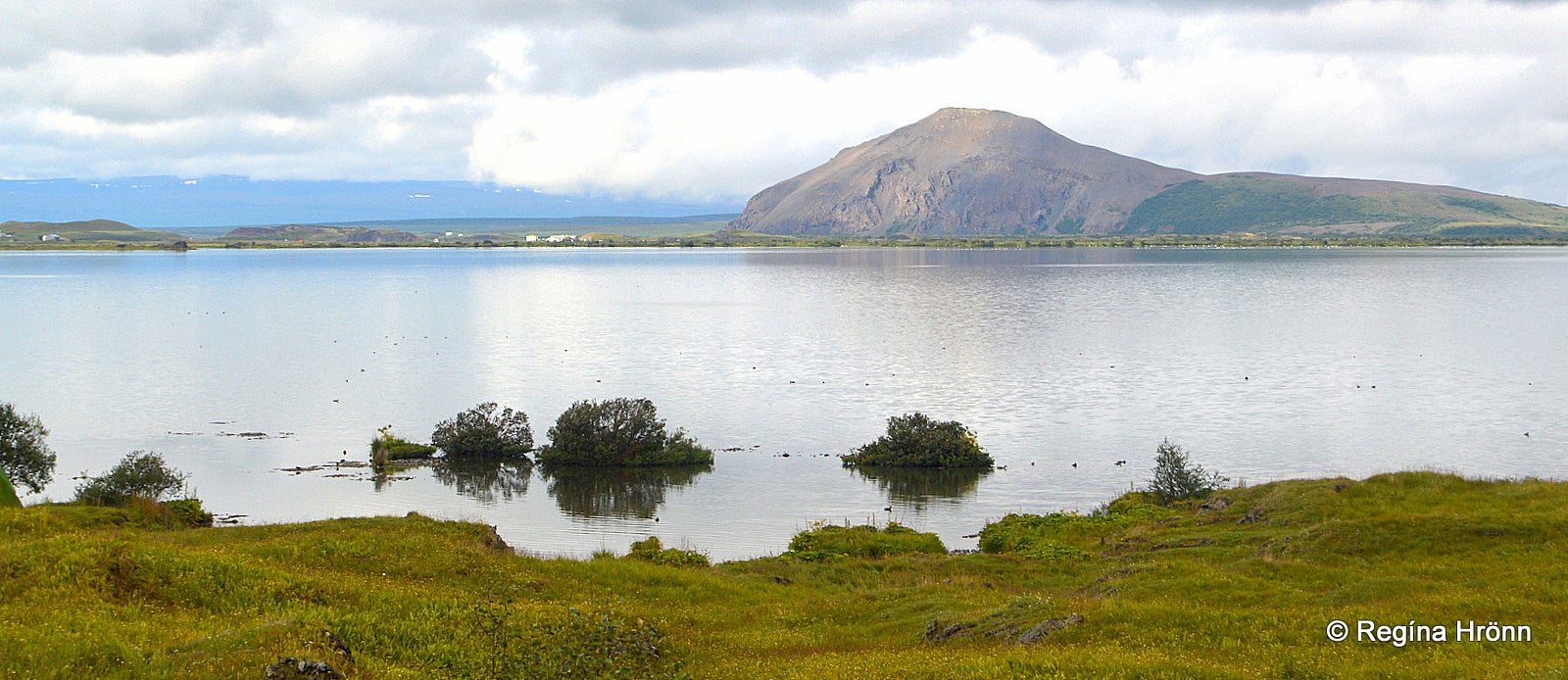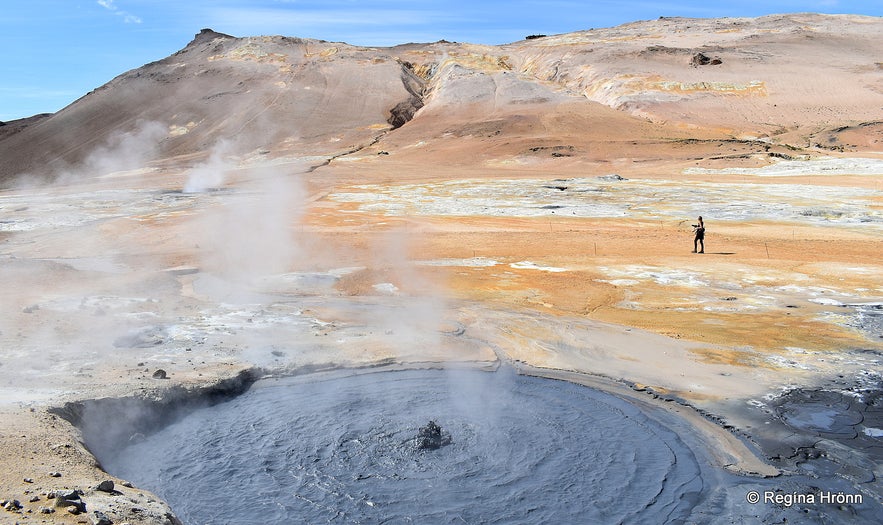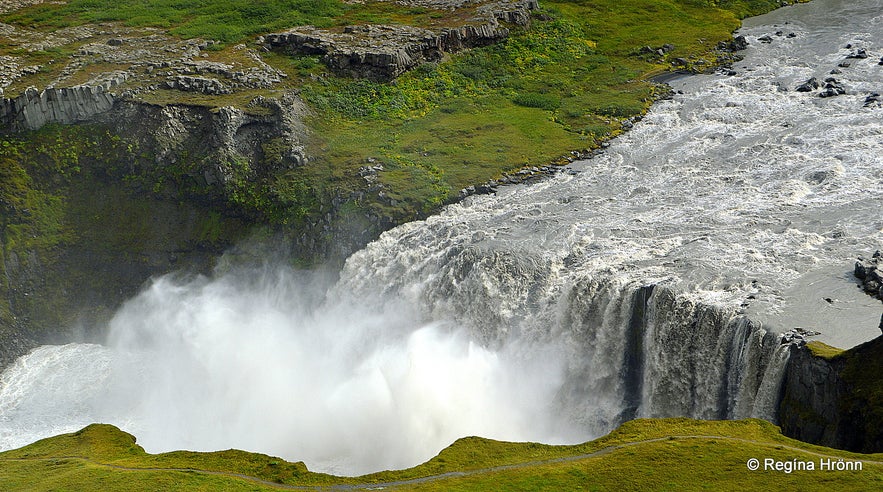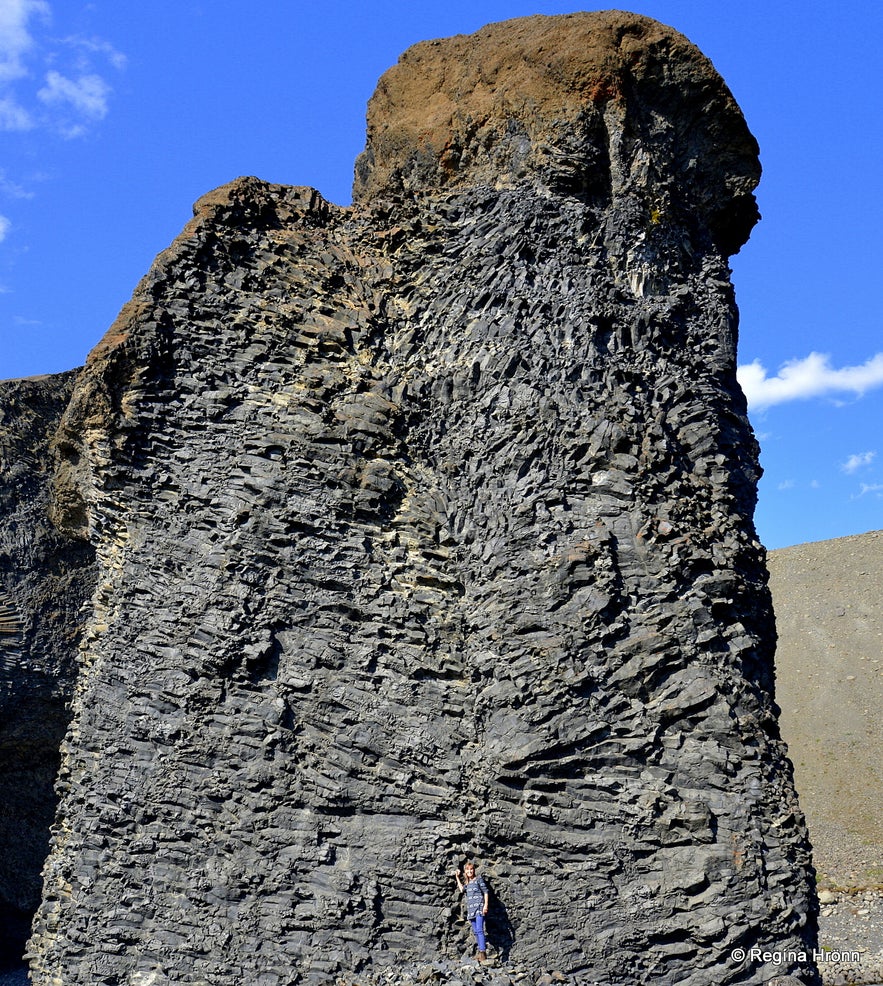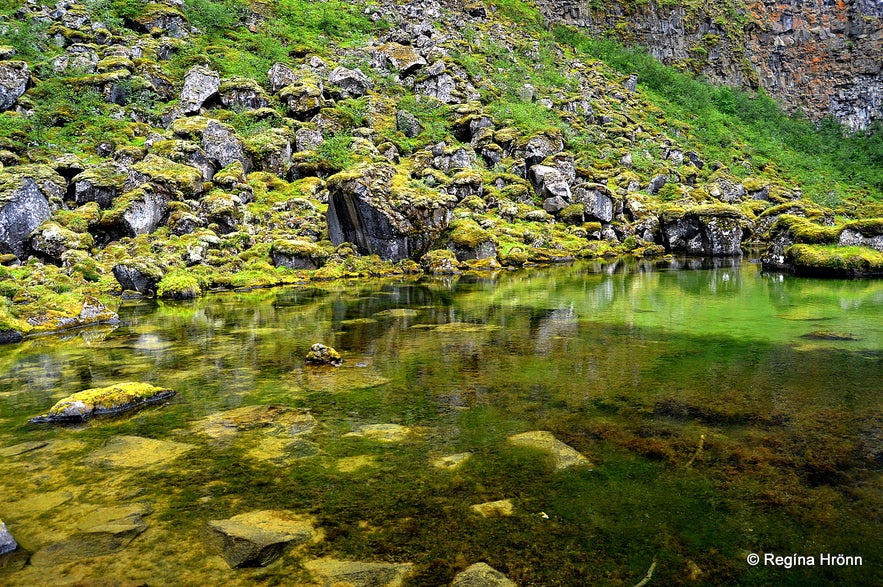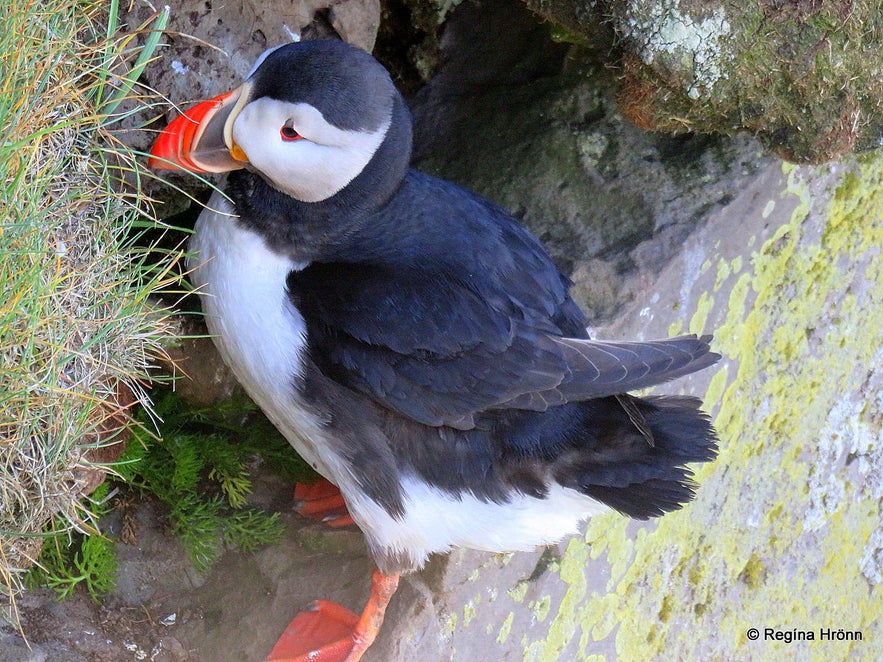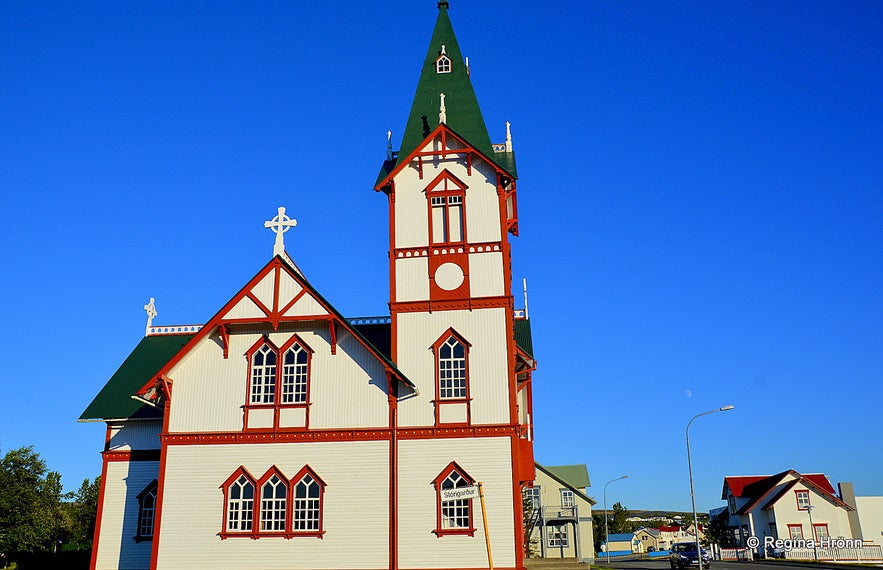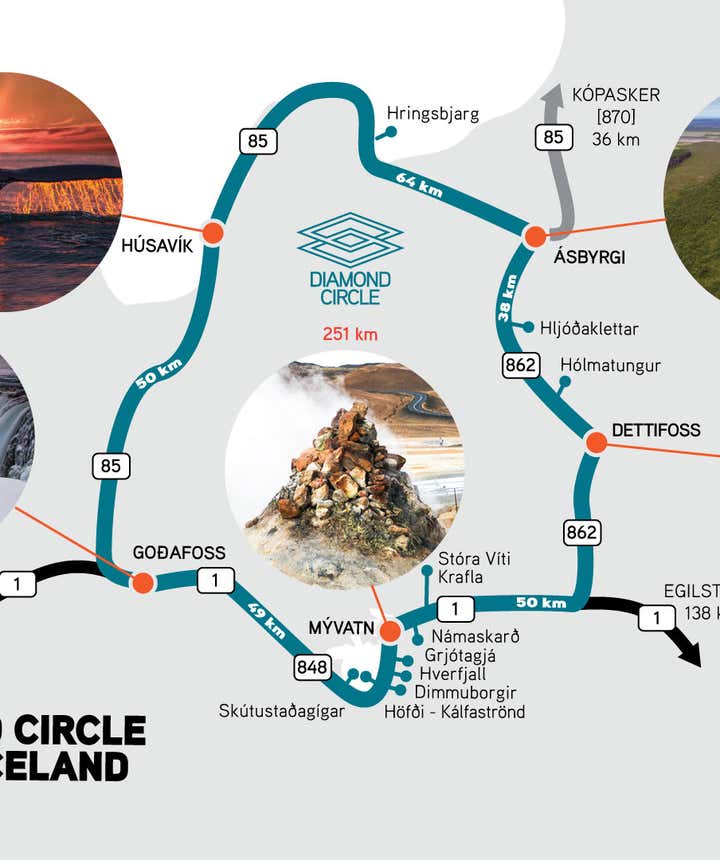
The spectacular Diamond Circle in North-Iceland
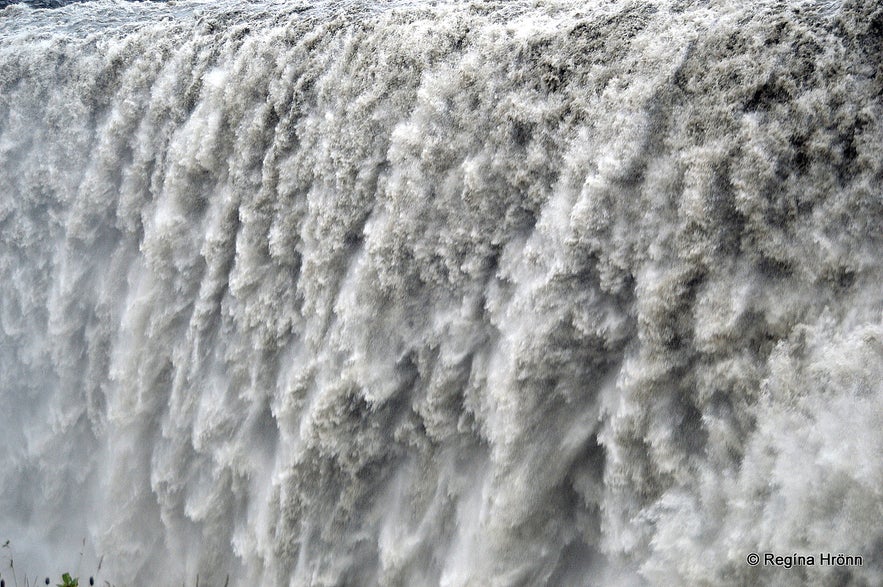
In South-Iceland we have got the Golden circle, and in West-Iceland we have got the Silver Circle, but did you know that we have got the Diamond Circle up north? I travelled up north and checked out the Diamond Circle to compare it with the very popular Golden Circle tours in the south.
I joined a guided tour, but I have also visited the Diamond Circle many many times on my own as we have a summer cottage at Mývatn.
Top photo: Dettifoss waterfall
Now, let me show you the beautiful highlights as visited on a guided tour:
Goðafoss waterfall - the Waterfall of the Gods
Goðafoss waterfall - the Waterfall of the Gods
Our first stop on the Diamond Circle was by Goðafoss waterfall, which is a beautiful and historical waterfall, right by ring road 1.
The name, Goðafoss - the Waterfall of the Gods - refers to the conversion to Christianity, which was made in the year 1000 in Iceland. The Lawspeaker and ex Pagan Chieftain, Þorgeir ljósvetningagoði, is said to have thrown his idols of the old pagan Nordic gods into this waterfall - right after returning from the Alþingi Parliament at Þingvellir where the conversion was made.
Thus the waterfall got its name Goðafoss - the Waterfall of the Gods. I always think about this Viking story when I visit this beautiful waterfall. We, unfortunately, haven't got a written source for this story, but it has lived on in oral history.
On this tour, we visited the west bank where you can get really close to the waterfall.
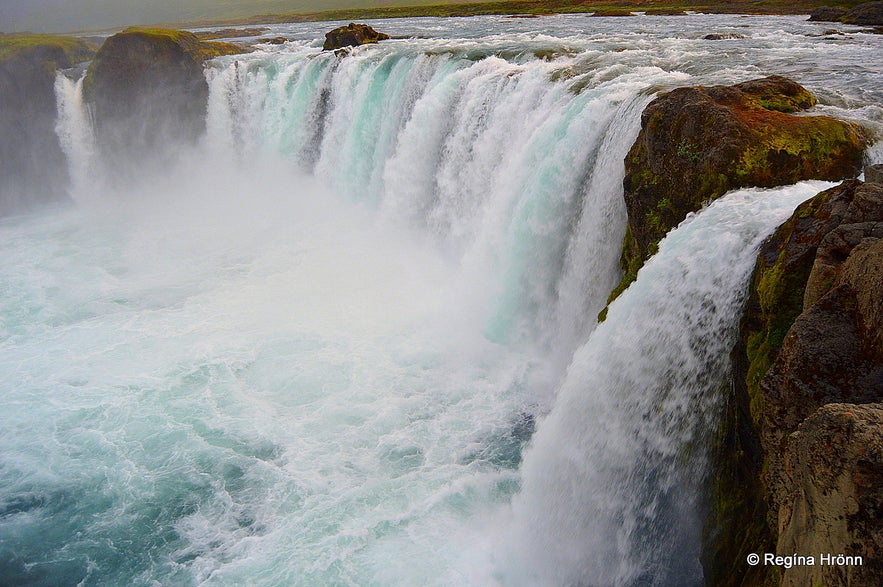
Goðafoss waterfall - the Waterfall of the Gods
This historical waterfall has a drop of 12 meters and a width of 30 meters and it cascades with great force down into the white and green river Skjálfandafljót. I love the green colour of this 180 km long glacial river.
You can walk really close to the edge, but as always caution is of utmost importance here as these glacial rivers are dangerous and ice cold.
I have written a detailed travel-blog about Goðafoss with many more photos:
The Historic Goðafoss Waterfall in Skjálfandafljót River in North-Iceland
Lake Mývatn
Lake Mývatn
We made our second stop, a short photo stop, by Lake Mývatn, which was created in a basaltic lava eruption 2,300 years ago. You will notice a myriad of freestanding lava formations in this area, including the lava pillars by and in Lake Mývatn.
Lake Mývatn is the 4th largest lake in Iceland, 37 km2, and is protected as a nature reserve. There is a very diverse birdlife on the lake and the lake is renowned for its many species of ducks and waterfowl.

Kálfastrandavagur at Mývatn
We also stopped at the supermarket at Mývatn to stock up on food and drinks for this long tour, as soon we would be leaving the inhabited areas and entering a glacial canyon.
Mývatn with its myriad of attractions is a must-see area in North Iceland.
I have written many travel-blogs about beautiful Mývatn, f.ex.:
The amazing Mývatn & Krafla Area in North-Iceland - a Compilation of the wonderful Sights
The wonderful Sights of Mývatn – the Northern Lights Capital of Iceland
Mt. Námafjall and the boiling mud pools
Alone at Hverir geothermal area by Mt. Námafjall
We now headed out to Mt. Námafjall and the high-temperature area, Hverir. Our 3rd stop was made by bubbling and boiling mud pools in a moon-like landscape.
A strong smell of sulfur fills the air here. It is truly an amazing part of Iceland.

A heart-shaped mud pool at Hverarönd geothermal area
We stopped for a brief moment here as we were headed for the glacial canyon.
See much more in my travel-blogs:
The Colorful Mt. Námafjall, Hverir and Leirhnjúkur in North Iceland
Jökulsárgljúfur canyon - Dettifoss waterfall
Dettifoss waterfall from the west bank
An hour later we entered the area of the Jökulsárgljúfur canyon and made our fourth stop at Dettifoss waterfall, where we strolled as a group down to this massive glacial waterfall.
Dettifoss is Iceland's most powerful waterfall and it blows my mind every time I visit it. Dettifoss is 45 meters high and 100 meters wide.

Dettifoss - the west bank
Dettifoss cascades in the glacial river, Jökulsá á Fjöllum which is the second-longest river in Iceland. The river originates in Vatnajökull glacier, Europe's largest ice cap by volume.
So you can see that this is a remarkable area - ruggedly beautiful and very impressive.
The water in glacial rivers is milky white and greyish - and ice cold. If you look closely at the photo above you will see how close the tiny people are to the edge of the waterfall on the east side!
I have been standing right where these people are standing and it is so mesmerizing that I would consider standing so close to be somewhat dangerous. So let's be very careful here.
There is a 15-minute (1 km) walk down to the waterfall on the west side. Our guide walked with us down to Dettifoss, where we stayed for 30 minutes. It started raining on this part of the tour, so I admired Dettifoss from the upper area and didn't walk down to the lower area.
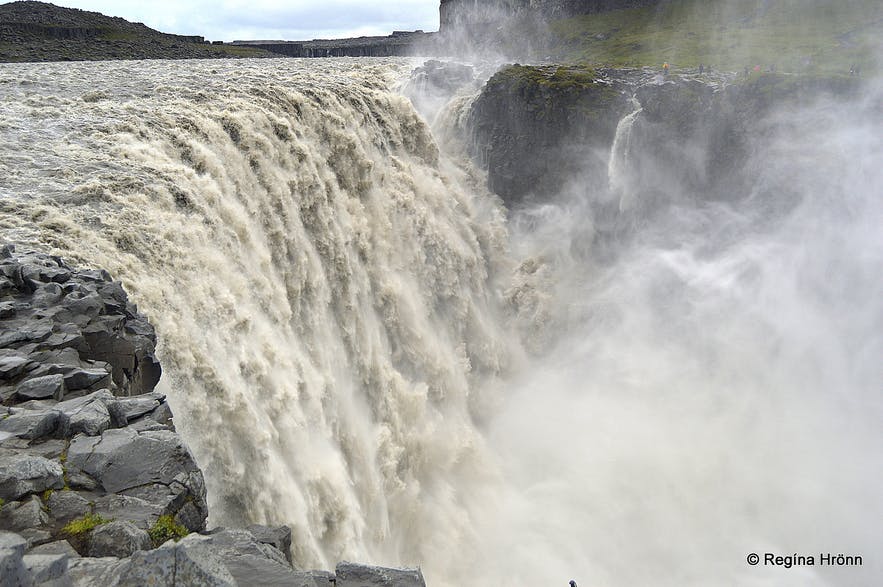
Dettifoss from the east bank
Some members of the groups did and were absolutely drenched when they came back up, both due to the rain and also due to the huge mist/spray of this massive waterfall.
But it is so worth it to go to the lower area and stand almost next to such a powerful waterfall.
The massive Dettifoss Waterfall in Jökulsárgljúfur Canyon in North-Iceland
Hafragilsfoss waterfall
Hafragilsfoss waterfall
Seeing that the Diamond Circle is a slow travel, then our guide let us choose which waterfall we would like to see next, Selfoss waterfall, which is above Dettifoss, or Hafragilsfoss waterfall, which is a couple of hundred meters below Dettifoss.
We opted for Hafragilsfoss waterfall as we could spot Selfoss waterfall in the distance, but Hafragilsfoss cannot be seen unless you drive for a short while on a bad road to have a look at it from above. Hafragilsfoss was our fifth stop on this tour. And the sun came out :)

Hafragilsundirlendi and Jökulsá á Fjöllum glacial river
Hafragilsfoss waterfall is also a beautiful waterfall with a huge mist/spray and a great view of the Jökulsárgljúfur canyon. To me, it looks like a mini Dettifoss. This waterfall is 27 meters high and is much less visited than the massive Dettifoss.
I have seen somewhere that the basalt rock formations in my photo above have been called the church of the elves (Hidden people) - although I have not been able to find any folklore to match this - but it is so beautiful that I will refer to it as the church of the elves and add the folklore if I eventually find it.
 Don't you agree with me that this beautiful basalt rock looks like a location where the elves would choose to have their church?
Don't you agree with me that this beautiful basalt rock looks like a location where the elves would choose to have their church?
I have written several other travel-blogs about the dwellings of the Icelandic elves if you want to see what elf churches look like:
The Elf-church Álfakirkja at Laugarvatnsvellir plains
The Beautiful Elf City and Elf Church by Hotel Laki in South-Iceland
Hljóðaklettar - Echo Rocks
Hljóðaklettar in Jökulsárgljúfur canyon
Our sixth stop was at Hljóðaklettar - Echo rocks - which looks like a fairytale landscape. Here we lost the sun again, so my photos are a tad dark. Hljóðaklettar cliffs are a cluster of columnar rock formations creating all kinds of figures. These huge basalt rock formations, by and in Jökulsá á Fjöllum glacial river, are volcanic plugs.
The glacial river has eroded these volcanic plugs over a period of many centuries - remember the sheer force of Dettifoss waterfall, the most powerful waterfall in Iceland - by that force the volcanic plugs have been sculptured through the ages.

Amazing basalt columns at Hljóðaklettar in Jökulsárgljúfur canyon
There are several trails in Hljóðaklettar, but our guide took us to the beautiful formation called the Troll, which is 0.6 km away from the parking lot. You can see the Troll in my first photo of Hljóðaklettar. It looks so majestic - but wait until you walk behind it!
There the most beautiful basalt column formations appear! It is overwhelming really and no matter how often I visit Hljóðaklettar and see these beautiful basalt column formations I say "wow"!
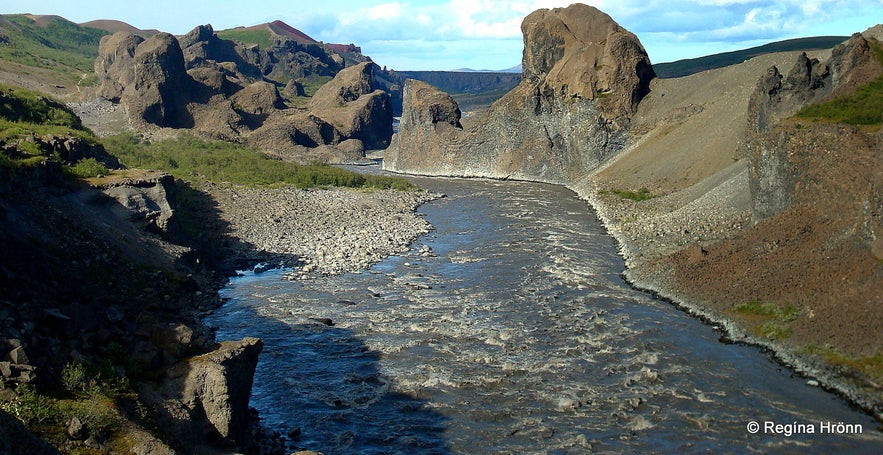
Hljóðaklettar in Jökulsárgljúfur canyon
I really love coming here to have a look at nature's work of art. And for sure walking amongst the basalt rock formations in Hljóðaklettar is like walking in an art gallery.
The extraordinary Hljóðaklettar – Echo Rocks in Jökulsárgljúfur Canyon
Ásbyrgi - the Shelter of the Gods
Botnstjörn pond at Ásbyrgi
Now we had reached the northern end of the Jökulsárgljúfur canyon and made our seventh stop at my favourite place in Iceland - my beloved Ásbyrgi - the Shelter of the Gods.
Ásbyrgi is one of the most magical places I have visited in Iceland and I am always in awe during my visit. I can understand why the elves chose Ásbyrgi as their capital city.
Psychic people have seen many homes, public buildings, and concert halls belonging to the elves in the cliffs.
Let's always show the elves respect and try not to make any racket in their capital city.
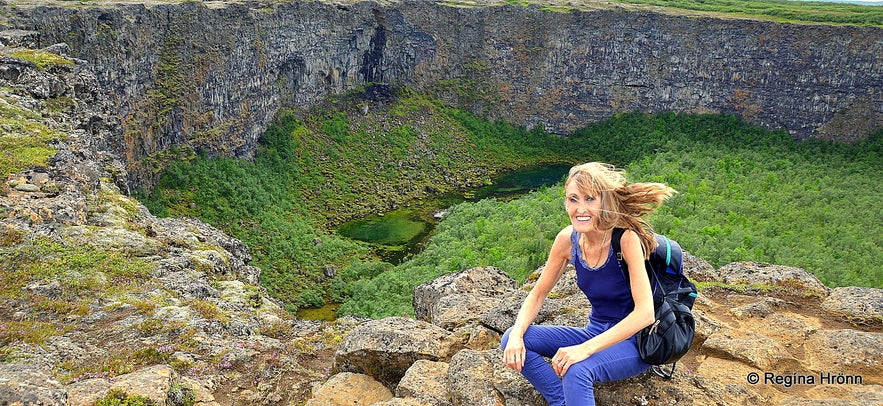
Botnstjörn pond at Ásbyrgi as seen from the hike on the rim of Ásbyrgi
Ásbyrgi is 3.5 km in length and 1.1 km across with up to 100 meters high walls! In Norse mythology, Ásbyrgi is said to be the hoof-print of the 8th-legged horse of Óðinn, Sleipnir. At the very bottom of Ásbyrgi, you will see the serene Botnstjörn pond.
Our guide walked with us down the steps to the pond and never left our side. This is what I like about fully guided tours - you have your guide with you the whole time.
Even though I know this area very well, then I am looking for tours where our foreign guests can feel totally safe in unknown areas.
If you want to join a Diamond Circle tour make sure you choose a fully guided tour and not partly guided - I have tried out both variations and was disappointed with the partly guided tour, so I recommend the fully guided tour for the best experience of the Diamond Circle.
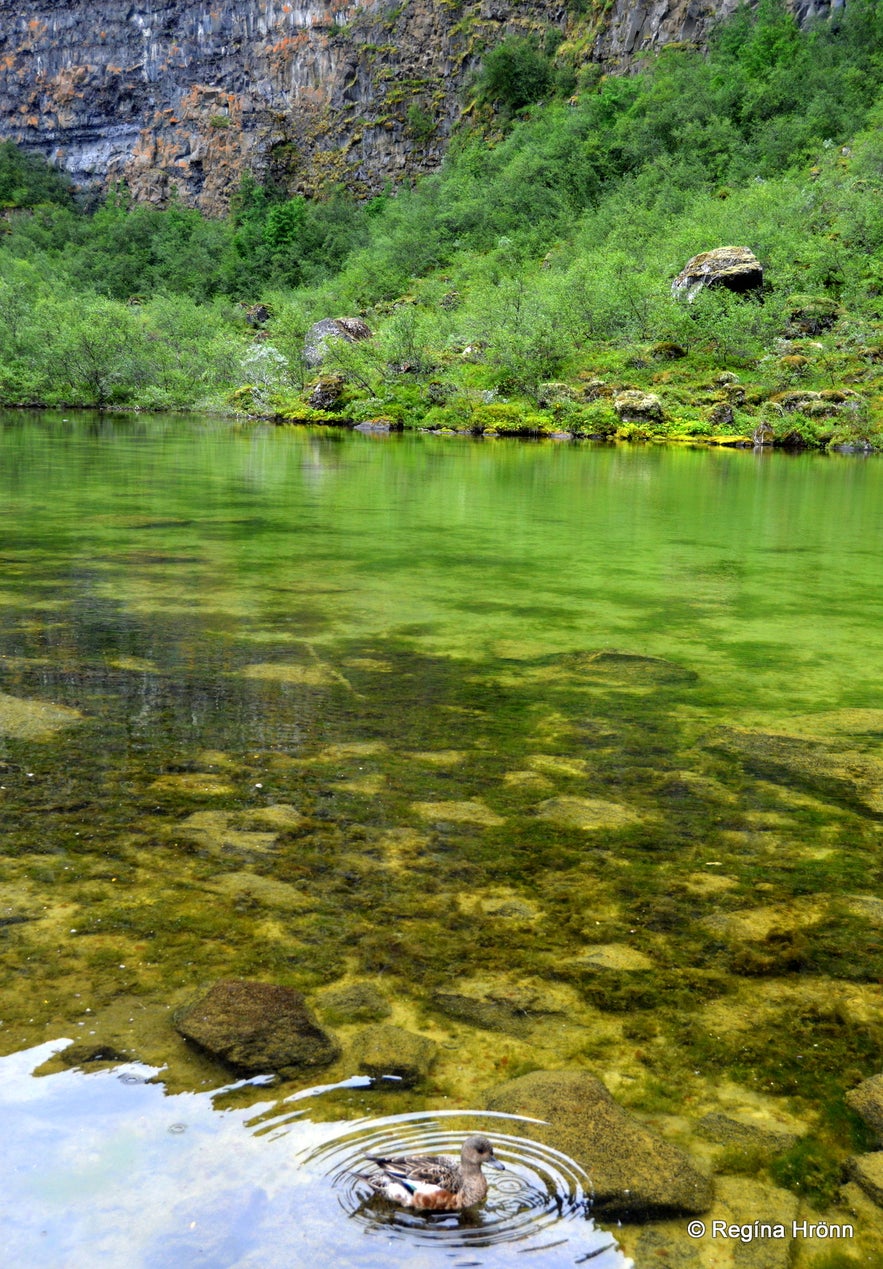
Botnstjörn pond at Ásbyrgi - wigeon
On the pond, you will find some types of ducks, the most common one being the wigeon. After enjoying a moment by the pond our guide walked with us to a higher view spot with an excellent view of the pond and the cliffs of Ásbyrgi.
We then had a much-appreciated coffee break at the cafè/restaurant at Ásbyrgi.
The beautiful Ásbyrgi Canyon and Botnstjörn Pond in North-East Iceland
Tjörnes and the puffins
A puffin at Hringsbjarg cliff
Our eighth stop was at Tjörnes peninsula where there are colonies of puffins during their nesting season in Iceland from April until mid-August. I joined this tour on the 4th of August so we managed to see a lot of puffins.
I adore this beautiful bird with the colourful beak and seek it out on my travels in my country.
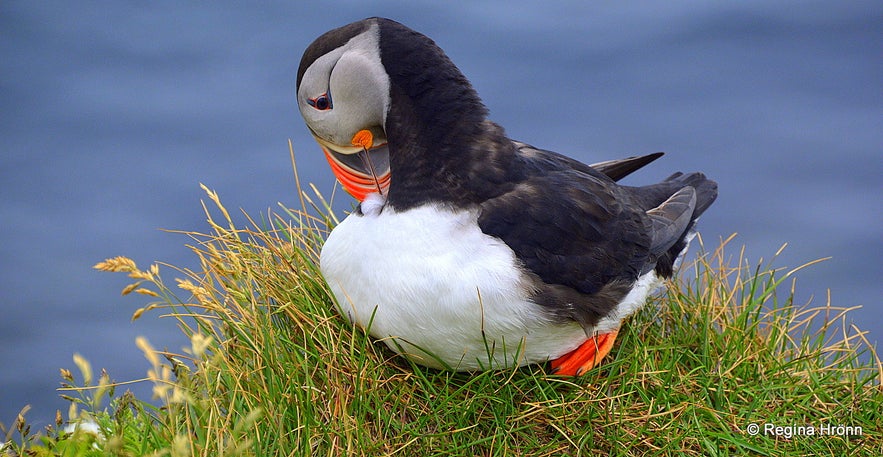
A puffin at Látrabjarg in the Westfjords, which I consider to be the best place to photograph a puffin
The puffin is so popular amongst our foreign visitors that it has almost become the symbol of Iceland :)
Tjörnes peninsula is also well known for its layers of fossil shells. And here you will also find the jewel of Tjörnes, Skeifárfoss waterfall.
See more in my travel-blog:
A breathtaking View from Hringsbjarg Cliff on Tjörnes Peninsula in North-Iceland
Húsavík - the Whale Watching Capital of Iceland
Húsavíkurkirkja church at Húsavík and the 2 houses built by my great-grandparents
Our ninth and last stop was a half an hour's stop at Húsavík the whale-watching capital of Iceland.
Húsavík is the birthplace of my grandmother and her 14 siblings and I grew up with stories from Húsavík, so I am very fond of this lovely little town. You can see my grandmother's former home next to the church.

Húsavíkurkirkja church and whales - the symbols of Húsavík
The church is sublime, and in my opinion, the most beautiful church in Iceland. It is very distinctive and there are only 2 other churches in Iceland built in the same style. Húsavíkurkirkja church was built in 1907.
The church was open and I had time to visit it and walk down to the busy harbour on this last stop of our tour.
I have written another travel-blog: Húsavík – the Whale Watching and Ja Ja Ding Dong Capital of Iceland, where I show you some of the locations of the American movie: Eurovision Song Contest - the Story of the Fire Saga.

Húsavík harbour
Remember Ármann, who guided me through Lofthellir cave - he was our guide on the Diamond Circle as well - a very knowledgeable and reliable guide, trained in the rescue team of Iceland.
Having a trained member of the rescue team as your guide is always reassuring, so I love travelling with Ármann :)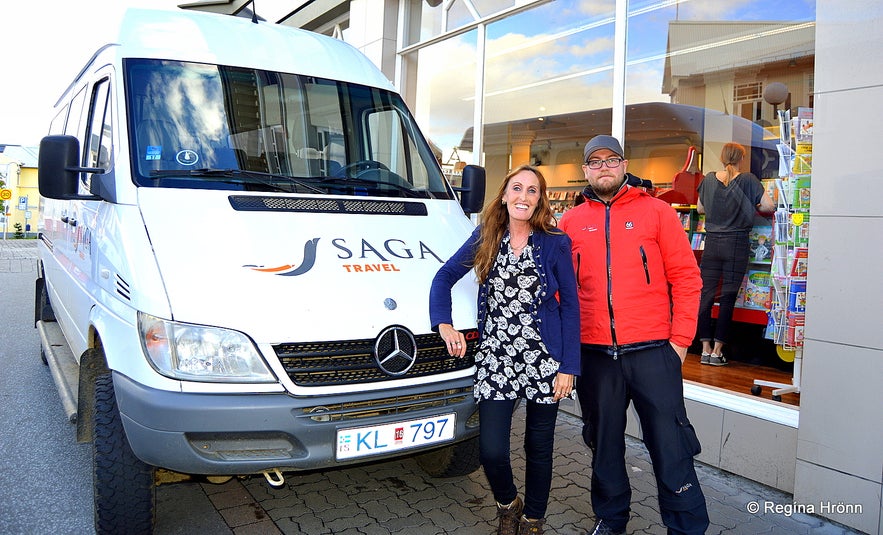
With Ármann the guide
Ármann now runs the company Imagine Iceland Travel with some very interesting tours up north, including a tour of the Diamond Circle.
The new logo (2020) of the Diamond Circle sent to me by Markaðsstofa Norðurlands - the Diamond Circle
I created this map above of the stops on the Diamond Circle - this is the first map I have ever created and I hope it gives you a better idea of the area called the Diamond Circle of Iceland :)
The Diamond Circle is a summer visit only as the roads to Dettifoss are not cleared of snow very often.
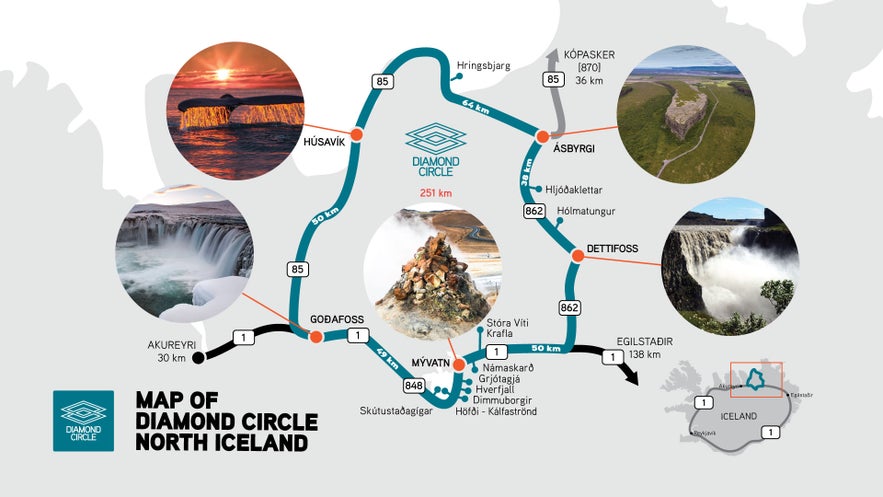
A new map of the Diamond Circle sent to me by Markaðsstofa Norðurlands - the Diamond Circle
I found it fitting to write this travel-blog on the Diamond Circle up north straight after my travel-blog about the Ice Diamond Beach in the south. Both these extraordinary places are not to be missed during a visit to my country.
Have a lovely time in North-Iceland :)
其他有意思的博客
冰岛最浪漫的角落
对于很多人,遥远的冰岛有着世界尽头的神秘,有着区别于巴黎、马尔代夫、自成一体的浪漫。没有埃菲尔铁塔和蒂凡尼,没有热带沙滩,而是在冰川、火山、苔藓地的背景下蜜月旅拍、婚拍,甚至举办一场冰岛婚礼。来冰岛旅行,多是要跨千山万水、飞跃大洋大陆,很有一点“万水千山陪你走过”的史诗感。难怪很多人说,光是冰岛二字,就足够浪漫了。 冰岛虽然不大,但是地貌极其丰富,不同的自然景观自然有不同的气质。这一篇,就挑阅读更多从极光观测到摄影-到底该不该来冰岛看极光
很多朋友都想来冰岛看极光,但是冰岛到底适不适合看极光呢?几月、什么季节能看到极光?是不是一定要参加北极光旅行团?如何能拍摄出美丽的极光照片呢?在冰岛住了好几年了,从刚开始逢极光必出门,到如今家里阳台就能看极光,我对在冰岛看极光的了解和经验,也算得上大半个专家了,且听我娓娓道来吧。 到底该不该来冰岛看极光呢?最坦诚的答案是,不要只为了看极光而看极光。 极光原理 太阳活动→太阅读更多
迷失冰岛的米湖游览推荐|不只有温泉的地热宝藏区
我在冬夏秋均到访过米湖,看过米湖的不同面。一直以来,米湖到底值不值得去是很多游客争论的问题。有些人觉得这里是来冰岛旅行的必去目的地,有些人则说米湖“太丑了”,连照片都不想多拍几张。那米湖到底值不值得来呢?到底怎么玩呢? 米湖的风景 北部的米湖,因地理位置相距首都雷克雅未克略远,很多来冰岛的短途游客选择放弃,其实米湖应该是和黄金圈、南岸沿线至冰湖齐名的冰岛景色,这里冷热相融,可谓最冰岛,尤其阅读更多

将冰岛最大的旅行平台下载到您的手机中,一站式管理您的整个行程
使用手机摄像头扫描此二维码,然后点击显示的链接,将冰岛最大的旅行平台添加到您的手机中。输入您的电话号码或电子邮件地址,以接收包含下载链接的短信或电子邮件。

